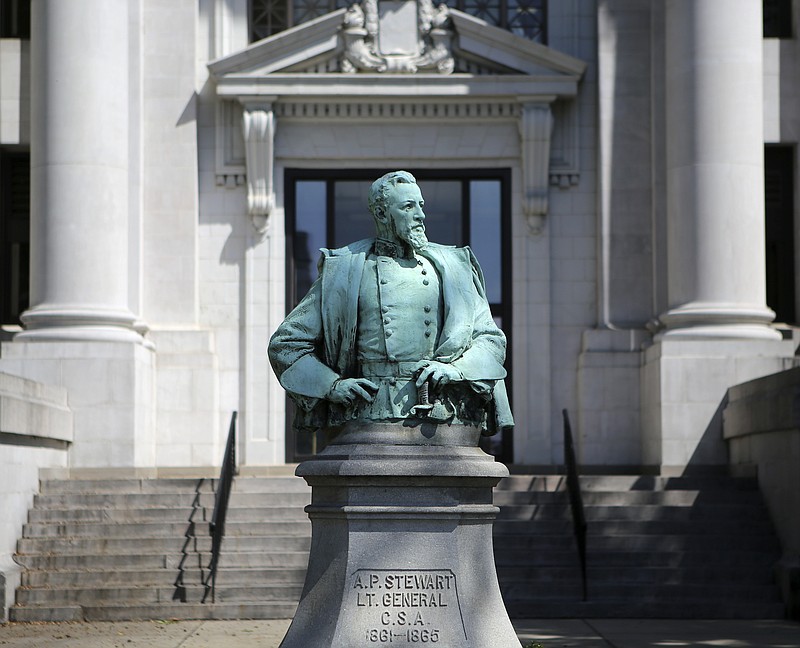The violent protests over removal of Confederate monuments and statues speak directly to why these relics should stand no longer in public places where they serve as reminders to America's still raw race pain.
Similarly, questions of whether we are rewriting history and changing culture offer opportunity - as do the calls to remove the monuments - for us to have important conversations.
What we do with these opportunities will determine whether we move toward healing or just widen a growing divide of hate.
To many people of color, monuments to and statues of former slave owners, slave traders and Ku Klux Klan leaders such as Nathan Bedford Forest stand as painful reminders.
To many southern whites and descendents of Confederate soldiers, the bronze likenesses of Forest and Robert E. Lee and others serve as relics of history.
Clearly, history is a relative thing.
We all share the Civil War history. We do not all share the same Civil War history.
Our president said last week: "You're changing history. Where does it stop?"
Changing history? No. We're not changing history. History was changed in the 1920s and 1960s when racists made heroes of slave owners and slave traders to erect these monuments a half century after the Civil War in order to make subtle fists in the faces of minorities.
The first and major spike in Confederate statue building began right after the Plessy v. Ferguson Supreme Court case established the "separate but equal" doctrine that gave rise to both Jim Crow laws and the formation of the NAACP. Another influence was the "nationalism" movement in the South following the first World War - that's also about the time the Klan made a comeback as the "Invisible Empire." Many of the Confederate statues went up then (and it became fashionable to name schools for Confederates) - between 1900 and 1919. It was a quiet, but in-your-face, symbol of supremacy.
History was changed again with another spike of Confederate memorializing and flag-waving in the decade after the next big Supreme Court decision involving race - the 1954 Brown v. Board of Education case.
Where does it stop?
The president and others ask where we draw the line. Are George Washington and Thomas Jefferson - both slave owners - next?.
It's actually pretty easy to draw this line. George Washington risked his life and fortune to create America. Robert E. Lee commanded the army that tried to dismantle America - the country Washington built.
Yes, Jefferson, by owning slaves, failed to live up to the ideals he penned into the U.S. Constitution: "that all men are created equal." But he did continually work toward laws that would end slavery and return slaves to the countries of their origin. Lee, on the other hand, served a rebel government based on the "cornerstone" that slavery was a black's "natural and moral condition."
Given these contrasts and the history that these statues (and our textbooks) both distort and omit, is it any wonder that race remains a sore spot in America? That's why we need the conversations.
Tennessee Gov. Bill Haslam has broken with some members of his own party and joined leaders like South Carolina Gov. Nikki Haley in removing Confederate battle flags. Haslam also has urged the removal of a statue of Nathan Bedford Forrest from the state Capitol. That will take some doing - and talking - since the Tennessee General Assembly passed a law requiring a two-thirds vote by the state historical commission (or an act of the legislature) to do so.
But here's a suggestion. In the process of having these conversations, let's look for solutions that broaden us all.
The Center for Civil War Research webpage lists 236 Confederate cemeteries in 22 states. The organization lists 10 cemeteries in Alabama, 48 in Georgia and 12 in Tennessee. And the website acknowledges there may be many more.
Many of these Confederate cemeteries are little known and uncelebrated, so why not explore moving some of these monuments from public statehouses and courthouse lawns and city parks to those Confederate resting places - the perfect site for memorialization and a location that is anything but an intended or unintended taunt.
It's also true that perhaps not all Confederate monuments need be moved.
With thoughtful conversation that might be the case with our local one and only Confederate statue of an individual, Gen. Alexander "A.P." Stewart, whose bust stands on the Hamilton County Courthouse lawn.
Stewart's likeness is there not because he was originally a Chattanooga son or because he embodied the old slave-owning stereotype of the Confederacy. He was none of those things. He's there because he was instrumental in the late 1890s and early 1900s in planning and creating of the nation's first military park - the military park aimed at healing our wounds by memorializing the soldiers, not the generals, of both sides.
Stewart and a former Union man, Gen. Joseph S. Fullerton, served as civilian "commissioners" to create the park and mend our divides.
Stewart died in 1908 and the Daughters of the Confederacy paid for the Stewart statue and had it placed at the courthouse in 1919.
A rational question is why a corresponding statue of the Union commissioner was not placed at the courthouse by a Union descendants group. But perhaps that's more fodder for the discussion now sought by the Chattanooga chapter of the NAACP. The NAACP, led by President Elenora Woods, is asking local leaders to move the Stewart statue.
